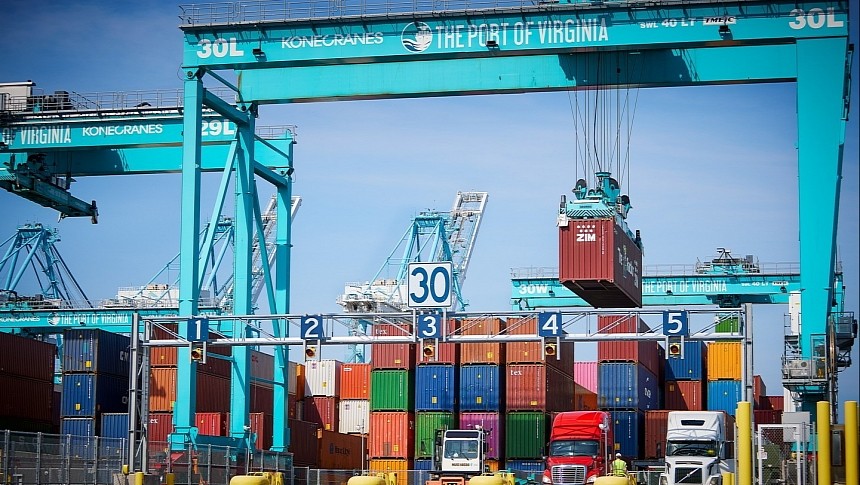With 2024 starting, global transport-related industries are one step closer to the 2040 net-zero target. One of the most impressive achievements in the new year is The Port of Virginia officially becoming the first one on the US East Coast to be powered exclusively by clean energy.
Both shipping and leisure cruising are betting on new-generation, green ships in order to meet the requirements for sustainable maritime transportation in the coming decades, but it takes more than that to lower emission levels significantly. Infrastructure plays a key role, and in 2023, we'll see more and more ports around the world adding green features in support of cleaner maritime operations.
At the beginning of 2024, the Port of Virginia is writing history as the first major port on the East Coast to use only clean energy to power all of its operations. The most remarkable part is that it's eight years earlier than the targeted deadline for this achievement, which had been originally planned for 2032. This could also speed up the journey to full carbon neutrality way before the global 2040 deadline.
The 100% clean energy will be used to power the Port of Virginia's fleet of electric equipment, which includes 116 stacking cranes, four rail cranes, and 27 ship-to-shore cranes. And this is just the beginning, as this innovative fleet will continue to grow. In the future, the Port plans to operate 152 stacking cranes, 31 ship-to-shore cranes, and seven rail cranes, all of them electric.
Port authorities have stated that the switch to clean energy will result in 45% fewer emissions per container. The areas that were mainly targeted for cutting emissions are the equipment exhaust and the electricity that's supplied to all the port buildings – these are known as Scope 1 and Scope 2 emissions, respectively.
In addition to harnessing clean energy, the Port of Virginia is also promoting sustainability by supporting an offshore wind farming project. It's pumping more than $200 million into a new hub at Portsmouth Marine Terminal (PMT), which aims to become the first offshore wind logistics hub on the US East Coast, another industry first.
This is part of the Coastal Virginia Offshore Wind project by Dominion Energy, which is claiming to be the largest of its kind in the US (a wind farm with 176 units).
The Port of Virginia's milestone and its ambitious wind farm-related projects are moving the US closer to clean energy pioneers such as the Nordic countries. The Port of Gothenburg, the largest Scandinavian port, has already implemented several innovative measures for sustainability and plans to become the premiere methanol hub in the region.
Norway is also closer to banning cruise ships running on conventional fuel from entering its fjords. Not even LNG, currently being used to power the newest cruise ships from the largest global operators, will be accepted in Norway's fjords starting in 2026. American ports are far from being that drastic, but seem to be moving in the same direction.
At the beginning of 2024, the Port of Virginia is writing history as the first major port on the East Coast to use only clean energy to power all of its operations. The most remarkable part is that it's eight years earlier than the targeted deadline for this achievement, which had been originally planned for 2032. This could also speed up the journey to full carbon neutrality way before the global 2040 deadline.
The 100% clean energy will be used to power the Port of Virginia's fleet of electric equipment, which includes 116 stacking cranes, four rail cranes, and 27 ship-to-shore cranes. And this is just the beginning, as this innovative fleet will continue to grow. In the future, the Port plans to operate 152 stacking cranes, 31 ship-to-shore cranes, and seven rail cranes, all of them electric.
Port authorities have stated that the switch to clean energy will result in 45% fewer emissions per container. The areas that were mainly targeted for cutting emissions are the equipment exhaust and the electricity that's supplied to all the port buildings – these are known as Scope 1 and Scope 2 emissions, respectively.
In addition to harnessing clean energy, the Port of Virginia is also promoting sustainability by supporting an offshore wind farming project. It's pumping more than $200 million into a new hub at Portsmouth Marine Terminal (PMT), which aims to become the first offshore wind logistics hub on the US East Coast, another industry first.
This is part of the Coastal Virginia Offshore Wind project by Dominion Energy, which is claiming to be the largest of its kind in the US (a wind farm with 176 units).
The Port of Virginia's milestone and its ambitious wind farm-related projects are moving the US closer to clean energy pioneers such as the Nordic countries. The Port of Gothenburg, the largest Scandinavian port, has already implemented several innovative measures for sustainability and plans to become the premiere methanol hub in the region.
Norway is also closer to banning cruise ships running on conventional fuel from entering its fjords. Not even LNG, currently being used to power the newest cruise ships from the largest global operators, will be accepted in Norway's fjords starting in 2026. American ports are far from being that drastic, but seem to be moving in the same direction.







